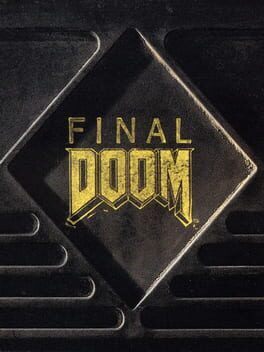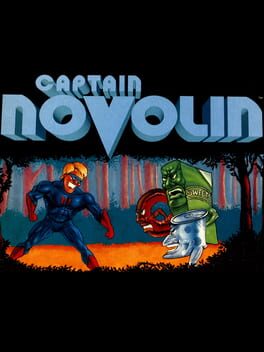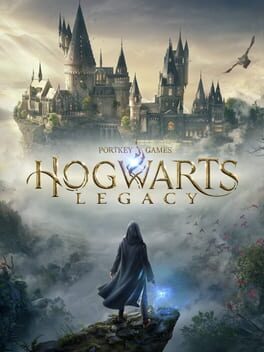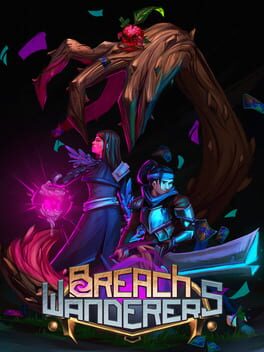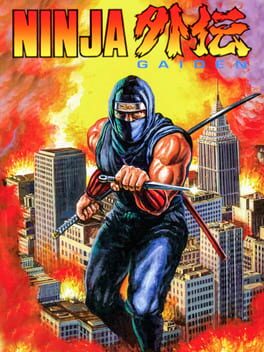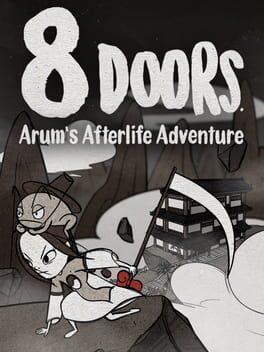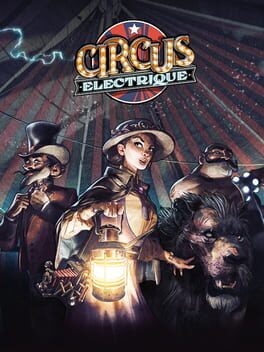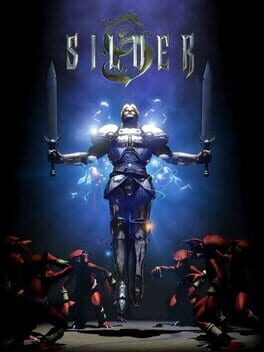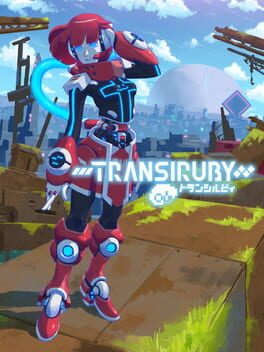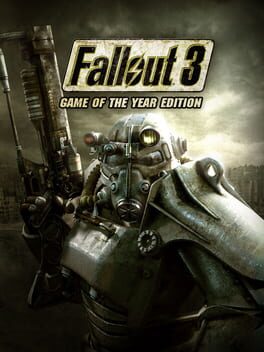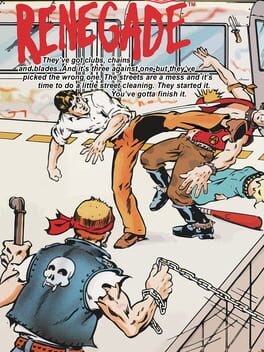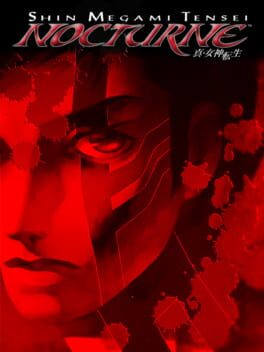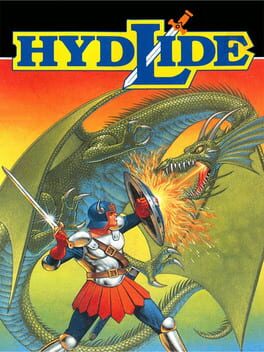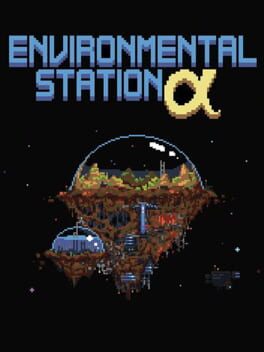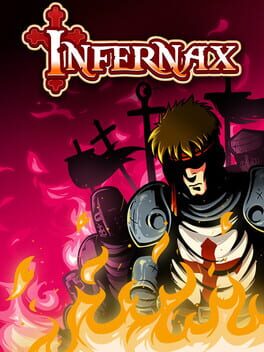Shenobi
1996
1992
I discovered this game at some point on a list of worst games of all-time (back when we only had systems up to the PSX and Saturn). I tried it out and it definitely felt like a pretty bad game -- not the worst ever, but definitely not really worthwhile.
However, I should note that it was amusing enough of an experience that I invited some friends over to try it out and they also got a good laugh out of the game, so I guess that's something?
However, I should note that it was amusing enough of an experience that I invited some friends over to try it out and they also got a good laugh out of the game, so I guess that's something?
2023
Short answer: It's a mixed bag of a game, with an open world that could feel fantastic but mostly just feels like sparsely populated locales with the same rotational stuff from one location transposed over another.
I'll try and avoid significant spoilers and mark where they are as necessary.
The game definitely has its moments -- there's a huge charm to Hogwarts (and to Hogsmeade, to a lesser extent), with lots of things that feel right at home in the HP universe making themselves known in both brazen and subtle ways.
I think that once I got to Hogwarts, I spent probably near four hours just wandering around and searching out all the experiences there are to find -- some of which come courtesy of a guidebook that's supposed to help your character out with their time in Hogwarts for this particular school year. The charm hits hard in the school and the promise of learning some really slick spells and putting them into practical application (read as: getting rid of baddies and solving puzzles) becomes tantalizing.
Once you've chosen to undertake the quests necessary to get yourself out of the school and gradually begin arming yourself with spells, combat seems like it might be an enterprising challenge that could make for a grand experience. Some enemies protect themselves with certain barriers, and you need to use spells relative to that barrier type to null the barrier in order to damage them, which complicates an enemy duel in an interesting way, as you need to be properly prepared to dispatch your enemy. But that's where the fun ends at with combat.
Spells do enough different stuff that they warrant being their own spell identity, but the damage spells definitely feel like damage spells and the "status" spells (for a lack of a better name for stuff that impedes your enemies) feel like more cleverly usable damage spells. But when you're fighting a number of enemies, some of which might have different barriers up, you're going to largely be focused on just casting the right color-grouped spell to disable an enemy and try and wail on that enemy while dodging other enemies before the one you're working on throws a barrier back up again. It's serviceable, if not a little annoying because the game seems to love throwing numerous enemies at you at once (this was on Normal difficulty for me, I don't know if enemy presence is more or less on Hard or the easier difficulties), so you're just committed to doing maintenance in battle instead of really engaging in experimenting with spells in fun ways. Or maybe that's just me!
Enemies scale with your level in all encounters I've had with the exception of one of the earliest main story quests, so there's no grinding levels to overpower your enemies as far as I can tell. Levels are basically HP and Talent Points, the latter of which can be used to mostly bolster spells and their effects, though one of those talent branches is quite busted.
Equipment loots can be acquired by searching locales or by defeating enemies, and loot has its own level to it and is nearly always found at the same level as you or one level higher, with stats generally around the same stats as what you already have, though maybe slightly higher or lower. You're always going to be roughly where you should be with encounters you happen upon, even without upgrading your equipment, unless you travel to certain parts of the world earlier, as enemies in certain parts of the world seem to have higher levels in order to discourage exploration before you're ready to go to said areas.
The worst thing about enemies is something that I think shouldn't be spoilered because people should know this -- there are very few enemy types, so with the meat of the game being focused on combat or just uncovering puzzles in tombs or Hogwarts or anywhere else, you're going to see a lot of repetition in short order once you get your freedom. Yes, the enemy typings come in multiple flavors, but they're not nearly diverse enough to overcome the fact that they really are just...more of the same thing. Even with specialized enemies you're treated to, you get a little profile notice that they're a unique enemy, but they look just like everyone else and might have a minor quirk about their combat tactics, but it's really just the same fight as everything else you've done, with one extra flourish involved, generally.
I encountered several bosses and I may have cheesed some of them with a very brutal one-shot tactic, but the major ones where I couldn't do that with were mostly just larger versions of enemies you've already seen with 1-2 extra moves based on the progression of the boss fight.
If you're searching for side-objectives just to complete, the game has you covered with so many options, but that's the main reason you're incentivized to wander the countryside. Because once you really travel around, you start noticing how insignificant other hamlets are as you discover them -- my favorite point to this is my character making the same "it's right out of a storybook" comment each time I enter one and in the case of a particular quest that had me traveling to each hamlet to acquire a particular item, I realized that some of them had VERY similar plots for how the hamlets were laid out.
Speaking of characters and their commentary, people are personable enough when you're introduced to them, but there are a couple lamentable overlaps -- first, you get to meet some seemingly unique characters in different hamlets or other locations, but they're almost always the exact same merchant types, so you get little variety in what you're purchasing from them, which makes them a bit less interesting beyond just asking them about what's going on in the local areas. Second, there's a weird issue with character models when talking, where between each sentence, their face reverts to the base character model "neutral" expression, which can lead to some very hilarious facial changes in conversations, which can really take you out of the moments.
High points for me?
Customizing the Room of Requirement whenever you unlock that is fun -- I went with a look that reminded me of Raya Lucaria from Elden Ring.
Also, I had a character at one point go, "There's something strange going on around here," and as she did, she rose about one foot off the ground and the table she was leaned against, which made her statement both hilarious and factual in the moment.
Exploring Hogwarts and its general grounds is a grand time and unlocking fast travel points (Floo Flames) makes the exploration feel extremely rewarding, especially given the the number of side quests you're thrown later on in the game as it finds ample opportunity to go, "Hey, have one more spell that may or may not have any impact on puzzles but will definitely be a separate option to ruin your same seven or eight enemy groups!"
Someone said it felt like an Ubisoft open-world game, and I kinda get that. For me, it's that Ubisoft level of open-worldness, but with a weaker WB-oriented combat system than Middle Earth or the Batman games. It feels very much like a game that belongs in the WB portfolio and if those games are your jam and you like the Harry Potter universe, it's probably a good fit for you and worth your time to check out. A friend gifted me this game and I was initially super-stoked to check it out, but I can't imagine buying it at full price with what I know now, as it just never felt like it kept my interest beyond that initial exploration of Hogwarts. I wasn't nearly as excited when I first left the grounds because it became very apparent that there just wasn't much variety in what you'd find when you started trying to dig deep into the exploratory side of the game. It's just a big world with some points that exist that you need to visit for reasons, and a lot of those points already reside in the two major areas of the game and the ones that don't, often have similar areas that feel somewhat copy-pasted, from hamlets to tombs.
How's that one spell go? Caveatus emptorum? I'm sure it's something like that.
I'll try and avoid significant spoilers and mark where they are as necessary.
The game definitely has its moments -- there's a huge charm to Hogwarts (and to Hogsmeade, to a lesser extent), with lots of things that feel right at home in the HP universe making themselves known in both brazen and subtle ways.
I think that once I got to Hogwarts, I spent probably near four hours just wandering around and searching out all the experiences there are to find -- some of which come courtesy of a guidebook that's supposed to help your character out with their time in Hogwarts for this particular school year. The charm hits hard in the school and the promise of learning some really slick spells and putting them into practical application (read as: getting rid of baddies and solving puzzles) becomes tantalizing.
Once you've chosen to undertake the quests necessary to get yourself out of the school and gradually begin arming yourself with spells, combat seems like it might be an enterprising challenge that could make for a grand experience. Some enemies protect themselves with certain barriers, and you need to use spells relative to that barrier type to null the barrier in order to damage them, which complicates an enemy duel in an interesting way, as you need to be properly prepared to dispatch your enemy. But that's where the fun ends at with combat.
Spells do enough different stuff that they warrant being their own spell identity, but the damage spells definitely feel like damage spells and the "status" spells (for a lack of a better name for stuff that impedes your enemies) feel like more cleverly usable damage spells. But when you're fighting a number of enemies, some of which might have different barriers up, you're going to largely be focused on just casting the right color-grouped spell to disable an enemy and try and wail on that enemy while dodging other enemies before the one you're working on throws a barrier back up again. It's serviceable, if not a little annoying because the game seems to love throwing numerous enemies at you at once (this was on Normal difficulty for me, I don't know if enemy presence is more or less on Hard or the easier difficulties), so you're just committed to doing maintenance in battle instead of really engaging in experimenting with spells in fun ways. Or maybe that's just me!
Enemies scale with your level in all encounters I've had with the exception of one of the earliest main story quests, so there's no grinding levels to overpower your enemies as far as I can tell. Levels are basically HP and Talent Points, the latter of which can be used to mostly bolster spells and their effects, though one of those talent branches is quite busted.
Equipment loots can be acquired by searching locales or by defeating enemies, and loot has its own level to it and is nearly always found at the same level as you or one level higher, with stats generally around the same stats as what you already have, though maybe slightly higher or lower. You're always going to be roughly where you should be with encounters you happen upon, even without upgrading your equipment, unless you travel to certain parts of the world earlier, as enemies in certain parts of the world seem to have higher levels in order to discourage exploration before you're ready to go to said areas.
The worst thing about enemies is something that I think shouldn't be spoilered because people should know this -- there are very few enemy types, so with the meat of the game being focused on combat or just uncovering puzzles in tombs or Hogwarts or anywhere else, you're going to see a lot of repetition in short order once you get your freedom. Yes, the enemy typings come in multiple flavors, but they're not nearly diverse enough to overcome the fact that they really are just...more of the same thing. Even with specialized enemies you're treated to, you get a little profile notice that they're a unique enemy, but they look just like everyone else and might have a minor quirk about their combat tactics, but it's really just the same fight as everything else you've done, with one extra flourish involved, generally.
I encountered several bosses and I may have cheesed some of them with a very brutal one-shot tactic, but the major ones where I couldn't do that with were mostly just larger versions of enemies you've already seen with 1-2 extra moves based on the progression of the boss fight.
If you're searching for side-objectives just to complete, the game has you covered with so many options, but that's the main reason you're incentivized to wander the countryside. Because once you really travel around, you start noticing how insignificant other hamlets are as you discover them -- my favorite point to this is my character making the same "it's right out of a storybook" comment each time I enter one and in the case of a particular quest that had me traveling to each hamlet to acquire a particular item, I realized that some of them had VERY similar plots for how the hamlets were laid out.
Speaking of characters and their commentary, people are personable enough when you're introduced to them, but there are a couple lamentable overlaps -- first, you get to meet some seemingly unique characters in different hamlets or other locations, but they're almost always the exact same merchant types, so you get little variety in what you're purchasing from them, which makes them a bit less interesting beyond just asking them about what's going on in the local areas. Second, there's a weird issue with character models when talking, where between each sentence, their face reverts to the base character model "neutral" expression, which can lead to some very hilarious facial changes in conversations, which can really take you out of the moments.
High points for me?
Customizing the Room of Requirement whenever you unlock that is fun -- I went with a look that reminded me of Raya Lucaria from Elden Ring.
Also, I had a character at one point go, "There's something strange going on around here," and as she did, she rose about one foot off the ground and the table she was leaned against, which made her statement both hilarious and factual in the moment.
Exploring Hogwarts and its general grounds is a grand time and unlocking fast travel points (Floo Flames) makes the exploration feel extremely rewarding, especially given the the number of side quests you're thrown later on in the game as it finds ample opportunity to go, "Hey, have one more spell that may or may not have any impact on puzzles but will definitely be a separate option to ruin your same seven or eight enemy groups!"
Someone said it felt like an Ubisoft open-world game, and I kinda get that. For me, it's that Ubisoft level of open-worldness, but with a weaker WB-oriented combat system than Middle Earth or the Batman games. It feels very much like a game that belongs in the WB portfolio and if those games are your jam and you like the Harry Potter universe, it's probably a good fit for you and worth your time to check out. A friend gifted me this game and I was initially super-stoked to check it out, but I can't imagine buying it at full price with what I know now, as it just never felt like it kept my interest beyond that initial exploration of Hogwarts. I wasn't nearly as excited when I first left the grounds because it became very apparent that there just wasn't much variety in what you'd find when you started trying to dig deep into the exploratory side of the game. It's just a big world with some points that exist that you need to visit for reasons, and a lot of those points already reside in the two major areas of the game and the ones that don't, often have similar areas that feel somewhat copy-pasted, from hamlets to tombs.
How's that one spell go? Caveatus emptorum? I'm sure it's something like that.
2021
First, this game is still in Early Access on Steam.
Second, there are mobile versions of this game for free, but they're built around paying your way to getting a faster accruing of wealth and experience to unlock more things.
With that out of the way, I really dig this game. As Roguelike Deckbuilders go, it just somehow finds a way to be exactly my jam. Deckbuilding feels truly thematic and independent of the characters you play as, though you can use their abilities to help break open your own deck ideas pretty easily.
The game is very particular about making sure you have an understanding of what's going on by piecing out each aspect of the game. Your first several runs will only be one area in length, as the game gives you a chance to learn its environment and unlock a few extra goodies to help make the real trips more fruitful. This is both a blessing and a curse, because anyone who wants to take their time and see all that the game has to offer is in for a treat, but anyone that wants to dive deep into the meat of the game to try and unlock postgame stuffs is going to be disappointed by having to take Guild Hall quests over and over to unlock each major area of the game and the Depth challenges that come with them.
If you're looking for challenge as deckbuilders go, you might have to self-impose when building your initial deck or save up wealth in the game to unlock the postgame content that alters some aspects of gameplay.
Gaining various types of wealth to unlock stuff is a bit of a slog, and is clearly a product of the mobile version, though the Steam version that I played does significantly raise the amount gained in runs to try and make up for this. But between characters, postgame modifiers, general upgrades for future runs, and even unlocking "packs" of cards, there's a lot available, of which you gain little after even the most successful of runs.
I don't mind doing a single run now and then to just make a little more progress because the deckbuilding just really feels right. There's a bug involving some achievements not unlocking until the next time you start up the game, but that's not exactly the worst thing in the world. I do also wish that it was a bit easier to tell the rarity of cards just by looking at them (it wasn't apparent to me) and that the mechanic for "Sort By" for your deck editor had a memory function to it so that it didn't always default back to a sort option you have no interest in using. There's also no controller support currently, and I don't know what the intentions are of the devs on potentially porting it to consoles to justify controller additions. Hopefully, it happens.
The final update for the game that will include more content for the official release is supposed to be coming up in the next few months, so if you're hard up on deckbuilders and want to really mess around with something fun, maybe consider giving it a go if you're on Steam. 15 bucks feels like it's in just the right price range for this game.
Second, there are mobile versions of this game for free, but they're built around paying your way to getting a faster accruing of wealth and experience to unlock more things.
With that out of the way, I really dig this game. As Roguelike Deckbuilders go, it just somehow finds a way to be exactly my jam. Deckbuilding feels truly thematic and independent of the characters you play as, though you can use their abilities to help break open your own deck ideas pretty easily.
The game is very particular about making sure you have an understanding of what's going on by piecing out each aspect of the game. Your first several runs will only be one area in length, as the game gives you a chance to learn its environment and unlock a few extra goodies to help make the real trips more fruitful. This is both a blessing and a curse, because anyone who wants to take their time and see all that the game has to offer is in for a treat, but anyone that wants to dive deep into the meat of the game to try and unlock postgame stuffs is going to be disappointed by having to take Guild Hall quests over and over to unlock each major area of the game and the Depth challenges that come with them.
If you're looking for challenge as deckbuilders go, you might have to self-impose when building your initial deck or save up wealth in the game to unlock the postgame content that alters some aspects of gameplay.
Gaining various types of wealth to unlock stuff is a bit of a slog, and is clearly a product of the mobile version, though the Steam version that I played does significantly raise the amount gained in runs to try and make up for this. But between characters, postgame modifiers, general upgrades for future runs, and even unlocking "packs" of cards, there's a lot available, of which you gain little after even the most successful of runs.
I don't mind doing a single run now and then to just make a little more progress because the deckbuilding just really feels right. There's a bug involving some achievements not unlocking until the next time you start up the game, but that's not exactly the worst thing in the world. I do also wish that it was a bit easier to tell the rarity of cards just by looking at them (it wasn't apparent to me) and that the mechanic for "Sort By" for your deck editor had a memory function to it so that it didn't always default back to a sort option you have no interest in using. There's also no controller support currently, and I don't know what the intentions are of the devs on potentially porting it to consoles to justify controller additions. Hopefully, it happens.
The final update for the game that will include more content for the official release is supposed to be coming up in the next few months, so if you're hard up on deckbuilders and want to really mess around with something fun, maybe consider giving it a go if you're on Steam. 15 bucks feels like it's in just the right price range for this game.
1988
This review contains spoilers
When this game doesn't get in the way of itself, it can actually be a fun time.
Level design is all over the place, ranging from interesting exploration to headache-inducing platforming (including escape sequences). Fast travel is one point per area, but for vital items that you might have missed, enjoy traipsing ALL THE WAY back through areas. I know that shouldn't sound bad in a Metroidvania, but this game started to grate on me after a little while when it came to going back to explore stuff.
Bosses are varying levels of okay-to-bad, in some cases just based on whether you're in the second phase or not. There are several bosses with attacks that follow based on what side you're on, so even if they telegraph the move to give you an opportunity to react, rolling past them or jumping in the opposite direction they're facing just means you're going to take a hit on the other side of them because they 180 on a dime.
In the case of one boss, you have an NPC assisting you for parts of the fight and it felt like the boss had a larger health bar because of this. I don't know if that's actually the case or not, but the fight felt like a slog because the boss had homing projectile attacks that would only come after you and since you're doing about 90% of the damage for this fight, you spend a good portion of the fight at times just dodging instead of being able to take a swing while NPC occasionally gets in a single hit every thirty seconds or so.
Weapons/weapon skills are a mixed bag, because some skills are vital abilities needed to make progression in the game and in conjunction with your ability tree, sometimes create really awkward scenarios just because of the dev's design choice. One weapon has a secondary ability to shield you from inclement weather and other hazards and you're required to use it against a boss. You have an ability that lets you check the health of a boss by using your weapon skill to hit the boss. What happens when you're forced to use a weapon that just acts as a shield when you're next to a boss? You end up standing there next to a boss, probably looking like an idiot.
I'm not suggesting that ability (seeing boss HP) is particularly important or necessary, but there's lots of little design decisions that don't make a lot of sense like this. That same weapon I mentioned can protect you from a hazard as long as you have it up, but you can't jump while you're using it and there's an area where you have to navigate down while holding up said weapon and there's spikes on either side of some ledges you can land on. What do you do if you land on a ledge? Well, you stand there until you decide to take a lot of damage because you're going to have to eat the hazard, the spikes, or both in order to proceed further down. If you get to that area, you'll probably understand what I mean, because I promise I'm making it sound way less annoying than it is if you have even a passing interest in getting secrets and exploring rooms.
Design rant incoming:
I think the most criminal design moment is the first (yes, there's two!) escape sequence you find around the halfway point in the game. You get about a half-screen's worth of distance from the boss the whole time and the sequence is probably somewhere around 90 seconds of precision platforming. Since your character has the ability to switch between their normal form and their companion's form (that of a giant frog that can use some gate-smashing abilities), you learn quickly (by dying) that you need to be in frog form to start the run.
When you get to the point where you need to use the frog's ability, you have to wait an extra moment longer than you think you do to use the ability. This is because the ability is tied to the same button as the roll / air-dash command and the prompt that shows up when you're in range of using said ability doesn't cause the ability to become active. You actually have to stop in order to activate it, THEN you can get things moving again.
You keep platforming and work your way further over and find another gated section your frog has to smash through in a different way. It's a charge-up move, so you need to stick the landing and set it up quickly because it takes a bit of time to get going. There is an ability on your ability tree that shortens charge time for frog's moves, but we'll come back to why this mostly doesn't matter shortly.
Assuming you get through all that, you think you're probably home free, so you do a bit more platforming (or just eating damage so you can use I-Frames to exploit air dashing and ignore some of the platforming), and reach a ledge. You can see another ledge on the other side, so you do what you know and jump/air-dash across to the other side from the ledge...and die because you were expected to fire a projectile past the edge of the screen that you could see to hit a lever to bring that platform over to the other side so you could clear a particular jump over there in order to keep going.
So, you rinse and repeat all this until the platforming goes right. Or quit the game. Because even though you have save checkpoints throughout the game, the developer of this game thought you should start right from this boss escape sequence over and over until you got it right. I mentioned that the charge time reduction ability wasn't really relevant, and this is largely why -- if you didn't purchase it before this point, you're definitely not purchasing it now. Since slight goofs bring the boss about 33% closer to you in each instance, it takes very little in the way of mistakes to have to restart the fight. I could easily see people giving up on the game during that fight because I already wasn't having a good time and mostly just wanted to play to see the end of the game instead of because I was enjoying myself.
End of design rant...or is it?
The next area of the game, you get a double jump ability. Use it by jumping in the air and then jumping again. Simple enough, right? It even has a sound cue to indicate the second jump happened. And this is where I think what should be a quality one would appreciate might exist because there was an issue with coding.
Your abilities you gain in each area get a lot of workout from them to make you feel like you're getting the most out of them. This particular area that requires double jumping has A LOT of platforms and wall jumping to navigate around. The problem is, sometimes you jump once and you suddenly hear the double jump sound. Lo and behold, you press the jump button again and nothing happens! Kinda makes me wonder if the sound cue was added in because something was wrong with the double jump and they wanted you to hear the cue so you could make a manual adjustment on the fly -- which I had to do probably several dozen times over the course of the next two areas.
TRUE end of design rant.
Beyond that, lots of little dialogue mistakes (mostly misspellings, but one particular story scene they refer to the character as "she", but then instruct someone multiple times to keep an eye on "him") and some impressive screen tearing in certain areas.
Soundtrack is okay, regular enemies are mostly fine. The one shining element of the game is that there's a lot of dialogue you can access if you really want to seek it out by going back and talking to the usual NPCs each time you make progress to a new area. Story's nothing to write home about, but they did do a solid job trying to establish some worldbuilding, so kudos for that, and it's largely why I give this two stars.
I quit at 70% area completion according to the game and I don't really see an interest in carrying on. It's not that I couldn't -- I just got tired of fighting the game and weird design decisions that made the experience less fluid than it should have been. I think it says something that I was looking at someone's map they made to make sure I didn't miss out on secrets, only to find out that -- in regards to the second sequence -- they quite literally mention that you shouldn't attempt the second sequence if you're in a bad mood and not having a good time trying to handle the controls. OOF.
Get it on deep sale, or get it in the Humble Monthly Bundle like I did. Not the worst Metroidvania, but it really tried to shoot itself in the foot with a rocket launcher.
Level design is all over the place, ranging from interesting exploration to headache-inducing platforming (including escape sequences). Fast travel is one point per area, but for vital items that you might have missed, enjoy traipsing ALL THE WAY back through areas. I know that shouldn't sound bad in a Metroidvania, but this game started to grate on me after a little while when it came to going back to explore stuff.
Bosses are varying levels of okay-to-bad, in some cases just based on whether you're in the second phase or not. There are several bosses with attacks that follow based on what side you're on, so even if they telegraph the move to give you an opportunity to react, rolling past them or jumping in the opposite direction they're facing just means you're going to take a hit on the other side of them because they 180 on a dime.
In the case of one boss, you have an NPC assisting you for parts of the fight and it felt like the boss had a larger health bar because of this. I don't know if that's actually the case or not, but the fight felt like a slog because the boss had homing projectile attacks that would only come after you and since you're doing about 90% of the damage for this fight, you spend a good portion of the fight at times just dodging instead of being able to take a swing while NPC occasionally gets in a single hit every thirty seconds or so.
Weapons/weapon skills are a mixed bag, because some skills are vital abilities needed to make progression in the game and in conjunction with your ability tree, sometimes create really awkward scenarios just because of the dev's design choice. One weapon has a secondary ability to shield you from inclement weather and other hazards and you're required to use it against a boss. You have an ability that lets you check the health of a boss by using your weapon skill to hit the boss. What happens when you're forced to use a weapon that just acts as a shield when you're next to a boss? You end up standing there next to a boss, probably looking like an idiot.
I'm not suggesting that ability (seeing boss HP) is particularly important or necessary, but there's lots of little design decisions that don't make a lot of sense like this. That same weapon I mentioned can protect you from a hazard as long as you have it up, but you can't jump while you're using it and there's an area where you have to navigate down while holding up said weapon and there's spikes on either side of some ledges you can land on. What do you do if you land on a ledge? Well, you stand there until you decide to take a lot of damage because you're going to have to eat the hazard, the spikes, or both in order to proceed further down. If you get to that area, you'll probably understand what I mean, because I promise I'm making it sound way less annoying than it is if you have even a passing interest in getting secrets and exploring rooms.
Design rant incoming:
I think the most criminal design moment is the first (yes, there's two!) escape sequence you find around the halfway point in the game. You get about a half-screen's worth of distance from the boss the whole time and the sequence is probably somewhere around 90 seconds of precision platforming. Since your character has the ability to switch between their normal form and their companion's form (that of a giant frog that can use some gate-smashing abilities), you learn quickly (by dying) that you need to be in frog form to start the run.
When you get to the point where you need to use the frog's ability, you have to wait an extra moment longer than you think you do to use the ability. This is because the ability is tied to the same button as the roll / air-dash command and the prompt that shows up when you're in range of using said ability doesn't cause the ability to become active. You actually have to stop in order to activate it, THEN you can get things moving again.
You keep platforming and work your way further over and find another gated section your frog has to smash through in a different way. It's a charge-up move, so you need to stick the landing and set it up quickly because it takes a bit of time to get going. There is an ability on your ability tree that shortens charge time for frog's moves, but we'll come back to why this mostly doesn't matter shortly.
Assuming you get through all that, you think you're probably home free, so you do a bit more platforming (or just eating damage so you can use I-Frames to exploit air dashing and ignore some of the platforming), and reach a ledge. You can see another ledge on the other side, so you do what you know and jump/air-dash across to the other side from the ledge...and die because you were expected to fire a projectile past the edge of the screen that you could see to hit a lever to bring that platform over to the other side so you could clear a particular jump over there in order to keep going.
So, you rinse and repeat all this until the platforming goes right. Or quit the game. Because even though you have save checkpoints throughout the game, the developer of this game thought you should start right from this boss escape sequence over and over until you got it right. I mentioned that the charge time reduction ability wasn't really relevant, and this is largely why -- if you didn't purchase it before this point, you're definitely not purchasing it now. Since slight goofs bring the boss about 33% closer to you in each instance, it takes very little in the way of mistakes to have to restart the fight. I could easily see people giving up on the game during that fight because I already wasn't having a good time and mostly just wanted to play to see the end of the game instead of because I was enjoying myself.
End of design rant...or is it?
The next area of the game, you get a double jump ability. Use it by jumping in the air and then jumping again. Simple enough, right? It even has a sound cue to indicate the second jump happened. And this is where I think what should be a quality one would appreciate might exist because there was an issue with coding.
Your abilities you gain in each area get a lot of workout from them to make you feel like you're getting the most out of them. This particular area that requires double jumping has A LOT of platforms and wall jumping to navigate around. The problem is, sometimes you jump once and you suddenly hear the double jump sound. Lo and behold, you press the jump button again and nothing happens! Kinda makes me wonder if the sound cue was added in because something was wrong with the double jump and they wanted you to hear the cue so you could make a manual adjustment on the fly -- which I had to do probably several dozen times over the course of the next two areas.
TRUE end of design rant.
Beyond that, lots of little dialogue mistakes (mostly misspellings, but one particular story scene they refer to the character as "she", but then instruct someone multiple times to keep an eye on "him") and some impressive screen tearing in certain areas.
Soundtrack is okay, regular enemies are mostly fine. The one shining element of the game is that there's a lot of dialogue you can access if you really want to seek it out by going back and talking to the usual NPCs each time you make progress to a new area. Story's nothing to write home about, but they did do a solid job trying to establish some worldbuilding, so kudos for that, and it's largely why I give this two stars.
I quit at 70% area completion according to the game and I don't really see an interest in carrying on. It's not that I couldn't -- I just got tired of fighting the game and weird design decisions that made the experience less fluid than it should have been. I think it says something that I was looking at someone's map they made to make sure I didn't miss out on secrets, only to find out that -- in regards to the second sequence -- they quite literally mention that you shouldn't attempt the second sequence if you're in a bad mood and not having a good time trying to handle the controls. OOF.
Get it on deep sale, or get it in the Humble Monthly Bundle like I did. Not the worst Metroidvania, but it really tried to shoot itself in the foot with a rocket launcher.
2022
Two things I don't care about: Circuses and the late 1800's. And yet, this game is golden, at least for me.
Bear in mind that I'm terrible about resource management games -- I've never beaten Darkest Dungeon, because I'm really good at being really bad at planning ahead of time. Circus Electrique mostly eschews that, though it's not necessarily apparent at first.
You've got a number of classes, but they generally become available either during the progression of the story or when you've leveled up the Train Station (the location where you hire your new performers). Character classes are interesting enough, but since you can't rework what moves your characters have like you can in Darkest Dungeon, what you see is what you get. And that's not necessarily a bad thing, as this game tends to try and keep things simple.
And on simple, prepping items for your journey is just a matter of having the resources (earned from encounters in the wild on your map paths) and then assigning them right before a battle. Your map for each given district is a sprawling path with multiple options, with each district having more options than before. If you fight a battle, your day ends and reports happen and you get your resources right afterwards and get to go back to the circus to upgrade or unlock or create any stuffs if you're capable of it. Going back out into the wild just puts you right back where you were on the map, so you're free to explore without losing your progress. It's nice in theory, but having the days end right after a battle can get a little tiresome by endgame, because you're often just having one random non-combat encounter in between each encounter and days passing means needing to deal with circus upkeep.
Not that circus upkeep is particularly bad -- you use a certain number of resources each day, and the only dire one is food supply, which you'll inevitably extend as long as you keep fighting things and exploring. You can also trade for food, but the cost mostly isn't worth it. Beyond that, you're putting on shows for people based on whatever open acts you have available. Your characters each have attributes to contribute to the act and if you meet the necessary requirements, those characters you've thrown into the act are off-limits for a day (or 2-4, depending on where you are in the game) and will be earning you rewards by participating. There's no reason not to run an act if you have extra characters available, because it's always extra resources and potential growth of your circus to the next level for more unlocks.
The bosses are probably my favorite part of this game, though they do suffer from being mostly easy compared to some of the random mixed parties you can fight along the way to them. Some bosses are one fixed unit that takes up all four spaces, and some bosses are unique singular units that have three other hench-things in tow to occupy the usual four slots, a la your Darkest Dungeon combat.
Gripes? Although I like the aesthetic, I wish more had been done with the music -- it's pleasant enough, but you're going to be hearing the same three or four tracks over and over and over and they're not long enough to warrant how much you're exposed to them.
Also, some of the control behaviors are a little weird -- I was playing on a gamepad and moving on the map between locations requires using the right analog stick to move because the left one is dedicated to setting your party and items up on the fly. But there's nothing really stopping just using a button to tab between the two menus, so it's a little cumbersome.
Finally, you've got a lot going on with positive and negative mental states and various kinds of buffs and debuffs and although the Information button is useful, it's a bit of a hassle to move through everything and some things aren't even explained -- I spent part of a run wondering if I was dealing with a bug because my characters were blazing through combat. Turned out that I had accidentally activated x2 speed on the gamepad and never realized it because I heard a sound that blended in with the rest of the action in the game and dismissed it as such.
Finally, the story's a bit of a nothingburger. It's not necessarily bad, but it's spread out through interviews throughout each district in the game and the portioning leaves something to be desired, because it's more of just "another thing in-between combats to deal with" instead of a particularly interesting investment of attention.
I engaged in a few of the side-fights that were available and one wave-based fight, and my total time from start to completion was roughly 21 hours. Repetition of fights aside, it's probably one of the more enjoyable purchases I've made in the last few years, so I'd say it's worth it at 19.99 new. Worst case scenario, wait for a sale on your preferred platform and get it at a steal. If you like these kinds of games, you'll definitely get some mileage on it and of course, there's postgame.
Bear in mind that I'm terrible about resource management games -- I've never beaten Darkest Dungeon, because I'm really good at being really bad at planning ahead of time. Circus Electrique mostly eschews that, though it's not necessarily apparent at first.
You've got a number of classes, but they generally become available either during the progression of the story or when you've leveled up the Train Station (the location where you hire your new performers). Character classes are interesting enough, but since you can't rework what moves your characters have like you can in Darkest Dungeon, what you see is what you get. And that's not necessarily a bad thing, as this game tends to try and keep things simple.
And on simple, prepping items for your journey is just a matter of having the resources (earned from encounters in the wild on your map paths) and then assigning them right before a battle. Your map for each given district is a sprawling path with multiple options, with each district having more options than before. If you fight a battle, your day ends and reports happen and you get your resources right afterwards and get to go back to the circus to upgrade or unlock or create any stuffs if you're capable of it. Going back out into the wild just puts you right back where you were on the map, so you're free to explore without losing your progress. It's nice in theory, but having the days end right after a battle can get a little tiresome by endgame, because you're often just having one random non-combat encounter in between each encounter and days passing means needing to deal with circus upkeep.
Not that circus upkeep is particularly bad -- you use a certain number of resources each day, and the only dire one is food supply, which you'll inevitably extend as long as you keep fighting things and exploring. You can also trade for food, but the cost mostly isn't worth it. Beyond that, you're putting on shows for people based on whatever open acts you have available. Your characters each have attributes to contribute to the act and if you meet the necessary requirements, those characters you've thrown into the act are off-limits for a day (or 2-4, depending on where you are in the game) and will be earning you rewards by participating. There's no reason not to run an act if you have extra characters available, because it's always extra resources and potential growth of your circus to the next level for more unlocks.
The bosses are probably my favorite part of this game, though they do suffer from being mostly easy compared to some of the random mixed parties you can fight along the way to them. Some bosses are one fixed unit that takes up all four spaces, and some bosses are unique singular units that have three other hench-things in tow to occupy the usual four slots, a la your Darkest Dungeon combat.
Gripes? Although I like the aesthetic, I wish more had been done with the music -- it's pleasant enough, but you're going to be hearing the same three or four tracks over and over and over and they're not long enough to warrant how much you're exposed to them.
Also, some of the control behaviors are a little weird -- I was playing on a gamepad and moving on the map between locations requires using the right analog stick to move because the left one is dedicated to setting your party and items up on the fly. But there's nothing really stopping just using a button to tab between the two menus, so it's a little cumbersome.
Finally, you've got a lot going on with positive and negative mental states and various kinds of buffs and debuffs and although the Information button is useful, it's a bit of a hassle to move through everything and some things aren't even explained -- I spent part of a run wondering if I was dealing with a bug because my characters were blazing through combat. Turned out that I had accidentally activated x2 speed on the gamepad and never realized it because I heard a sound that blended in with the rest of the action in the game and dismissed it as such.
Finally, the story's a bit of a nothingburger. It's not necessarily bad, but it's spread out through interviews throughout each district in the game and the portioning leaves something to be desired, because it's more of just "another thing in-between combats to deal with" instead of a particularly interesting investment of attention.
I engaged in a few of the side-fights that were available and one wave-based fight, and my total time from start to completion was roughly 21 hours. Repetition of fights aside, it's probably one of the more enjoyable purchases I've made in the last few years, so I'd say it's worth it at 19.99 new. Worst case scenario, wait for a sale on your preferred platform and get it at a steal. If you like these kinds of games, you'll definitely get some mileage on it and of course, there's postgame.
1999
This is one of the few Dreamcast games I didn't enjoy on some level at all. I feel like I remember seeing reviews of this game getting a 3/10 and I thought, "An RPG for the DC, how can this be a bad thing?"
Don't let me stop you from discovering what kind of gem this game is. It might even be worth at least 1.5 stars!
Don't let me stop you from discovering what kind of gem this game is. It might even be worth at least 1.5 stars!
2021
Can a Metroidvania be a little too simple? For me, that's the case with Transiruby.
I really enjoy the graphics -- color choices contrast well so there's a lot of eye candy going on and pixelated art feels crisp.
The music is catchy enough, but very limited in tracks. I'm particularly fond of the music from the second area of the game, as it reminds me a bit of Wonderboy in Monster World's opening music that's a reprisal of Mecha Dragon's Castle.
In theory, there's a lot of exploration, but also...there's actually not. Progression in the game is made by collecting these mini-chips -- and when you have enough, you can open a door to another area...with more chips. But also, there's a lot of one-shot gating items located here and there between worlds, so a lot of time is spent going back and forth between worlds with your one new item, just so you can open up one more door or start one more platform to progress to the next mini-area full of chips in the major area before one of those checkpoint doors.
On controls in general, they're extremely precise and movement feels absolutely golden when traversing platforms.
Combat is way too easy -- it's just swinging your blade by repeatedly pressing the Sword button, occasionally choosing to down-swing if you want to plunge onto enemies. You can also fire shots at smaller enemies -- you use this a lot for freezing enemies so you can either get life back occasionally from kills or to have them function as stepping stones for climbing. Enemies die REALLY easily to the downward plunge attack.
Bosses are a joke. The patterns are especially simple, and inevitably you get an obvious opening where you take a huge chunk of their health with an appropriate stab. Most damage you deal when their weaknesses aren't exposed is insignificant and just used to charge your gun, which you can't normally use on bosses anyway.
The thing is, even with the bosses and enemies being fairly pedestrian, you might occasionally die (especially if you discover how very much you can't swim as a robot-girl). But it's not really a big deal, as the game is very proactive in maintaining your progress to the best of its ability -- you die, you spawn at either the last key item you picked up, the last save point, or even the last optional item you picked up. Save points are practically irrelevant unless you're trying to be extra careful. Die to a boss? Get dropped outside the boss room with full health. In fact, the save points don't heal you, so it's generally more useful to just take a death after the game autosaves your progress because you get full health and full EP for your gun on respawn.
The game is just a continuous treading and retreading of the same ground while picking up chips to make progress and if that's your jam (the retreading -- everyone loves chips), then you'll probably dig it. But without a sense of challenge, it's hard to really appreciate the game beyond the fact that it's short and sweet -- I can't see it taking more than eight hours for a first-time player.
One weird thing worth noting -- in order to quit the game, you have to go to the option menu while in-game, choose to return to the title screen, then go to the option menu in the title screen, then choose to quit the game. What a strange place to allow the user to exit the game from.
I believe it's priced at 14.99 on Steam. I can't recommend it at that price, but if you see it on sale for 50% off, you could definitely do worse than to kill a few very easy hours with some catchy music. I'd rate it higher, but it just didn't do anything for me.
I really enjoy the graphics -- color choices contrast well so there's a lot of eye candy going on and pixelated art feels crisp.
The music is catchy enough, but very limited in tracks. I'm particularly fond of the music from the second area of the game, as it reminds me a bit of Wonderboy in Monster World's opening music that's a reprisal of Mecha Dragon's Castle.
In theory, there's a lot of exploration, but also...there's actually not. Progression in the game is made by collecting these mini-chips -- and when you have enough, you can open a door to another area...with more chips. But also, there's a lot of one-shot gating items located here and there between worlds, so a lot of time is spent going back and forth between worlds with your one new item, just so you can open up one more door or start one more platform to progress to the next mini-area full of chips in the major area before one of those checkpoint doors.
On controls in general, they're extremely precise and movement feels absolutely golden when traversing platforms.
Combat is way too easy -- it's just swinging your blade by repeatedly pressing the Sword button, occasionally choosing to down-swing if you want to plunge onto enemies. You can also fire shots at smaller enemies -- you use this a lot for freezing enemies so you can either get life back occasionally from kills or to have them function as stepping stones for climbing. Enemies die REALLY easily to the downward plunge attack.
Bosses are a joke. The patterns are especially simple, and inevitably you get an obvious opening where you take a huge chunk of their health with an appropriate stab. Most damage you deal when their weaknesses aren't exposed is insignificant and just used to charge your gun, which you can't normally use on bosses anyway.
The thing is, even with the bosses and enemies being fairly pedestrian, you might occasionally die (especially if you discover how very much you can't swim as a robot-girl). But it's not really a big deal, as the game is very proactive in maintaining your progress to the best of its ability -- you die, you spawn at either the last key item you picked up, the last save point, or even the last optional item you picked up. Save points are practically irrelevant unless you're trying to be extra careful. Die to a boss? Get dropped outside the boss room with full health. In fact, the save points don't heal you, so it's generally more useful to just take a death after the game autosaves your progress because you get full health and full EP for your gun on respawn.
The game is just a continuous treading and retreading of the same ground while picking up chips to make progress and if that's your jam (the retreading -- everyone loves chips), then you'll probably dig it. But without a sense of challenge, it's hard to really appreciate the game beyond the fact that it's short and sweet -- I can't see it taking more than eight hours for a first-time player.
One weird thing worth noting -- in order to quit the game, you have to go to the option menu while in-game, choose to return to the title screen, then go to the option menu in the title screen, then choose to quit the game. What a strange place to allow the user to exit the game from.
I believe it's priced at 14.99 on Steam. I can't recommend it at that price, but if you see it on sale for 50% off, you could definitely do worse than to kill a few very easy hours with some catchy music. I'd rate it higher, but it just didn't do anything for me.
1987
Yo, I heard you like JRPGs so we made one of the best and most difficult JRPGs of all-time.
People talk about Ornstein & Smough as "the gatekeepers", but it seems like they forgot about Matador.
Karma systems got you down? Go play in the Fifth Kalpa and prove that the best answer to a karma system is to just smash it to pieces and be the god that other games only dream of raising you to.
Secrets? We got those. Really odd minigame for one Magatama that most people will need an FAQ for? We got you covered there, too!
Extra bosses? OH, HELL YEAH, WE GOT THOSE.
A rainbow worm that is one of the most powerful teammates you could ever have? You bet we've got that in this game.
The ability to fuse monsters to make bosses you've already beaten and have them be on your team? Well...why wouldn't this game have that?
Seriously -- if you've never played this and you like turn-based RPGs, put down whatever you're doing and go play this instead. It's your duty as an RPG lover to see what lies beyond the fifth kalpa.
People talk about Ornstein & Smough as "the gatekeepers", but it seems like they forgot about Matador.
Karma systems got you down? Go play in the Fifth Kalpa and prove that the best answer to a karma system is to just smash it to pieces and be the god that other games only dream of raising you to.
Secrets? We got those. Really odd minigame for one Magatama that most people will need an FAQ for? We got you covered there, too!
Extra bosses? OH, HELL YEAH, WE GOT THOSE.
A rainbow worm that is one of the most powerful teammates you could ever have? You bet we've got that in this game.
The ability to fuse monsters to make bosses you've already beaten and have them be on your team? Well...why wouldn't this game have that?
Seriously -- if you've never played this and you like turn-based RPGs, put down whatever you're doing and go play this instead. It's your duty as an RPG lover to see what lies beyond the fifth kalpa.
1984
Let me get the gripes out of the way before I gush, because they're bothersome enough that I feel like they're worth mentioning.
-- I'm not a fan of tying the Horizontal and Vertical Dash upgrades to the same button, because it's very easy to accidentally tilt slightly up while in movement and V-Dash when you totally meant to H-Dash, and consequently end up falling flat on your face or eating boss damage like it's candy. Maybe that's a controller-only issue, I don't know. I just know it happened to me enough times that it was significantly noticeable.
-- Despite the game sometimes holding your hand about the general idea of where to go, there are some subsections of the station that can be a bit of a pain to navigate or to be certain where you need to go to get there. Hard to really complain here, since I love exploration, but if I know I'm in the right area and I'm still having trouble figuring out how to progress, maybe the pathing could be a little better.
-- Putting a kill-plane right below a boss for an area you're expected to drop down to is just garbo. Especially if you haven't gotten the "Cheat My Face Off" power-up to make your movement nice and easy.
-- The woodland biome had a couple branches that felt like actual ledges when they weren't. Minor frustration, but it happened enough times that I felt like noting it.
With that out of the way, let's talk about why this game is some solid gold.
The boss design is pretty good in most cases (assuming you're playing on Normal -- on Easy, you can probably tank most of the bosses in a run without much grief). There's some optional bosses in the main game that will also be more than happy to take you to task if you can reach them.
Power-ups feel significant and it's very easy to see how they impact your movement through the world. The hookshot is a little cumbersome at first, but once you get a handle on your angles, it's amazing fun to just launch yourself into the air off a well-timed use of it. The game also does an excellent job of really getting you used to using these abilities, because you'll absolutely need them by the end of the game.
General world design is clever, with lots of hidden passages for you to wander into -- some are obvious, some are not, and some will leave you scratching your head as to what the point of them is, at first.
And that leads us to where the real shine of this game is -- the postgame. The postgame asks you to beat those main game optional bosses and make sure you've got all the power-ups you need, then gives you the opportunity to use them to navigate some hellish area designs that result in even more optional boss encounters and several additional endings. Clues are scattered all over the station while you're playing the main game -- veritable hints to let you know that something more significant is going on. Frankly, I'd recommend a guide for the postgame because it's just that overwhelming of a level of exploration.
Beyond that, the music's pleasant, the graphics are rough but work well enough that you're largely able to appreciate everything that's going on without having to squint to figure out what's what in a retro-looking game.
In short, the game has a few drawbacks that keep it from being in my personal pantheon of the best of Metroidvanias, but if you're looking for a solid one, it's well worth it to pick this up at full price -- a whopping eight bucks. You could always keep an eye out for a sale, though -- as I write this, the Steam Winter Sale is going on and the game has been discounted 60%, down to $3.19 USD. If you're a fan of Metroidvanias, do this dev a solid and support them because they definitely earned it with ESA.
-- I'm not a fan of tying the Horizontal and Vertical Dash upgrades to the same button, because it's very easy to accidentally tilt slightly up while in movement and V-Dash when you totally meant to H-Dash, and consequently end up falling flat on your face or eating boss damage like it's candy. Maybe that's a controller-only issue, I don't know. I just know it happened to me enough times that it was significantly noticeable.
-- Despite the game sometimes holding your hand about the general idea of where to go, there are some subsections of the station that can be a bit of a pain to navigate or to be certain where you need to go to get there. Hard to really complain here, since I love exploration, but if I know I'm in the right area and I'm still having trouble figuring out how to progress, maybe the pathing could be a little better.
-- Putting a kill-plane right below a boss for an area you're expected to drop down to is just garbo. Especially if you haven't gotten the "Cheat My Face Off" power-up to make your movement nice and easy.
-- The woodland biome had a couple branches that felt like actual ledges when they weren't. Minor frustration, but it happened enough times that I felt like noting it.
With that out of the way, let's talk about why this game is some solid gold.
The boss design is pretty good in most cases (assuming you're playing on Normal -- on Easy, you can probably tank most of the bosses in a run without much grief). There's some optional bosses in the main game that will also be more than happy to take you to task if you can reach them.
Power-ups feel significant and it's very easy to see how they impact your movement through the world. The hookshot is a little cumbersome at first, but once you get a handle on your angles, it's amazing fun to just launch yourself into the air off a well-timed use of it. The game also does an excellent job of really getting you used to using these abilities, because you'll absolutely need them by the end of the game.
General world design is clever, with lots of hidden passages for you to wander into -- some are obvious, some are not, and some will leave you scratching your head as to what the point of them is, at first.
And that leads us to where the real shine of this game is -- the postgame. The postgame asks you to beat those main game optional bosses and make sure you've got all the power-ups you need, then gives you the opportunity to use them to navigate some hellish area designs that result in even more optional boss encounters and several additional endings. Clues are scattered all over the station while you're playing the main game -- veritable hints to let you know that something more significant is going on. Frankly, I'd recommend a guide for the postgame because it's just that overwhelming of a level of exploration.
Beyond that, the music's pleasant, the graphics are rough but work well enough that you're largely able to appreciate everything that's going on without having to squint to figure out what's what in a retro-looking game.
In short, the game has a few drawbacks that keep it from being in my personal pantheon of the best of Metroidvanias, but if you're looking for a solid one, it's well worth it to pick this up at full price -- a whopping eight bucks. You could always keep an eye out for a sale, though -- as I write this, the Steam Winter Sale is going on and the game has been discounted 60%, down to $3.19 USD. If you're a fan of Metroidvanias, do this dev a solid and support them because they definitely earned it with ESA.
2022
I know there's a lot going on in this game beyond my experience with it because I had to look at some guides and see just how much I missed.
The most important thing to state about this game is that it's hard. Very hard. You could mitigate this by messing with the Accessibility options to give yourself invincibility and/or infinite jumps to pad the difficulty, but I'd recommend at least trying to get through areas until you're feeling absolutely stuck by some of the platforming/Castlevania-ish feel before considering messing with these things, because I feel like the devs really went out of their way to try and ease you into each ability learned or hazard presented as naturally as possible.
There's a morality system that's mostly interesting, albeit minorly frustrating because it's sometimes less than obvious as to which choice you should make if you're trying to play good or evil with your character. This can be a problem if you're like me because you thought that sparing a particular character might have been a good thing, but it ended up being a negative action further down the line that locked me out of further quests in order to get the best Good-Aligned ending. Whoops!
Bosses were mostly a great time (including some of the optionals I got to fight), though I could do without Alastor, The Hopeless -- and the infinite platforming while VERY SLOWLY whittling my way through that fight.
Money gains feel more grindy than experience gains, but maybe that's just me. All items feel like they're worth the grind in the end, though -- every bit of power or magic or healing slots or whatnot feels like it counts.
MINOR SPOILER NOTE START
------------------------------------------------
Music's solid, the obvious nods to the games that inspired it are wonderful, the secret endings are a fun time to get (consider sleeping five times in a row in the first inn when you unlock the ability to do so), and there's even alternate / secret characters to play as (try the Konami code on the title screen when you're done playing the regular game).
-------------------------------------
MINOR SPOILER NOTE END
20 bucks on Steam feels like a reasonable price for the content I haven't even gotten to touch in the game yet, though I feel like a guide is mandatory if you're intending to unlock some of the endings, because it really is that easy to get locked into a mistake, especially once you unlock this game's equivalent of Fast Travel and discover some particular quests that you must decide on the spot to undertake or not.
On sale, the game would be a steal for anyone looking for a challenging platformer throwback with creative boss fights and that massive nostalgia creep. If you don't mind slamming your head against some brick wall difficulty moments, this is a gem that should not be overlooked. I might have to revise my nominees for 2022 games on here.
The most important thing to state about this game is that it's hard. Very hard. You could mitigate this by messing with the Accessibility options to give yourself invincibility and/or infinite jumps to pad the difficulty, but I'd recommend at least trying to get through areas until you're feeling absolutely stuck by some of the platforming/Castlevania-ish feel before considering messing with these things, because I feel like the devs really went out of their way to try and ease you into each ability learned or hazard presented as naturally as possible.
There's a morality system that's mostly interesting, albeit minorly frustrating because it's sometimes less than obvious as to which choice you should make if you're trying to play good or evil with your character. This can be a problem if you're like me because you thought that sparing a particular character might have been a good thing, but it ended up being a negative action further down the line that locked me out of further quests in order to get the best Good-Aligned ending. Whoops!
Bosses were mostly a great time (including some of the optionals I got to fight), though I could do without Alastor, The Hopeless -- and the infinite platforming while VERY SLOWLY whittling my way through that fight.
Money gains feel more grindy than experience gains, but maybe that's just me. All items feel like they're worth the grind in the end, though -- every bit of power or magic or healing slots or whatnot feels like it counts.
MINOR SPOILER NOTE START
------------------------------------------------
Music's solid, the obvious nods to the games that inspired it are wonderful, the secret endings are a fun time to get (consider sleeping five times in a row in the first inn when you unlock the ability to do so), and there's even alternate / secret characters to play as (try the Konami code on the title screen when you're done playing the regular game).
-------------------------------------
MINOR SPOILER NOTE END
20 bucks on Steam feels like a reasonable price for the content I haven't even gotten to touch in the game yet, though I feel like a guide is mandatory if you're intending to unlock some of the endings, because it really is that easy to get locked into a mistake, especially once you unlock this game's equivalent of Fast Travel and discover some particular quests that you must decide on the spot to undertake or not.
On sale, the game would be a steal for anyone looking for a challenging platformer throwback with creative boss fights and that massive nostalgia creep. If you don't mind slamming your head against some brick wall difficulty moments, this is a gem that should not be overlooked. I might have to revise my nominees for 2022 games on here.
